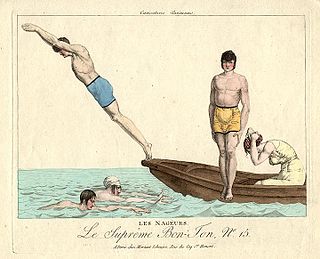
Knitting is a method for production of textile fabrics by interlacing yarn loops with loops of the same or other yarns. It is used to create many types of garments. Knitting may be done by hand or by machine.

A swimsuit is an item of clothing designed to be worn by people engaging in a water-based activity or water sports, such as swimming, diving and surfing, or sun-orientated activities, such as sun bathing. Different types may be worn by men, women, and children. A swimsuit can be described by various names, some of which are used only in particular locations, including swimwear, bathing suit, swimming costume, bathing costume, swimming suit, swimmers, swimming togs, bathers, cossie, or swimming trunks for men, besides others.
Speedo International Limited is a British distributor of swimwear and swim-related accessories based in Nottingham, England, known for its swim briefs. The company has roots in Australia but is not based there anymore. Founded in Sydney in 1914 by Alexander MacRae, a Scottish emigrant, the industry-leading company is now a subsidiary of the British Pentland Group. Today, the Speedo brand can be found on products ranging from swimsuits and goggles to wristwatches. The Speedo brand was previously manufactured for and marketed in North America as Speedo USA by PVH, under an exclusive perpetual licence, which had acquired prior licensee Warnaco Group in 2013. As of January 2020, the Pentland Group purchased back the rights from PVH for $170 million in cash, subject to regulatory approval.

A one-piece swimsuit most commonly refers to swimwear worn primarily by women and girls when swimming in the sea or in a swimming pool, playing water polo, or for any activity in the sun, such as sun bathing. Today, the one-piece swimsuit is usually a skin-tight garment that covers the torso, although some designs expose the back or upper chest.

The Aran jumper is a style of jumper that takes its name from the Aran Islands off the west coast of Ireland. A traditional Aran Jumper usually is off-white in colour, with cable patterns on the body and sleeves. Originally the jumpers were knitted using unscoured wool that retained its natural oils (lanolin) which made the garments water-resistant and meant they remained wearable even when wet.

Knitting is the process of using two or more needles to pull and loop yarn into a series of interconnected loops in order to create a finished garment or some other type of fabric. The word is derived from knot, thought to originate from the Dutch verb knutten, which is similar to the Old English cnyttan, "to knot". Its origins lie in the basic human need for clothing for protection against the elements. More recently, hand knitting has become less a necessary skill and more of a hobby.

Competitive swimwear refers to the swimsuit, clothing, equipment, and accessories used in the aquatic sports of swimming, diving, synchronized swimming, triathlon, and water polo.
Catalina is a brand of women’s swimwear. It was once one of the oldest clothing manufacturers in California. Their history began in 1907, as Bentz Knitting Mills, a small manufacturer of underwear and sweaters. The name was changed to Pacific Knitting Mills in 1912, accompanied by the introduction of swimwear to their existing knit lines. The name was changed again finally to Catalina in 1928.
Intarsia is a knitting technique used to create patterns with multiple colours. As with the woodworking technique of the same name, fields of different colours and materials appear to be inlaid in one another, fit together like a jigsaw puzzle.

Knitted fabric is a textile that results from knitting, the process of inter-looping of yarns or inter-meshing of loops. Its properties are distinct from woven fabric in that it is more flexible and can be more readily constructed into smaller pieces, making it ideal for socks and hats.

A burkini is a style of swimsuit for women. The suit covers the whole body except the face, the hands and the feet, while being light enough for swimming. This type of swimwear was designed with the intention of creating swimwear for Muslims who observe hijab in this way. The amount of skin covered is about the same as the person wearing a wetsuit and a swimming cap.

Thelma R. Payne was an American diver won the bronze medal in the 3 meter springboard at the 1920 Summer Olympics. She also won the springboard at the AAU Championships in 1918–1920. Payne was AAU national champion in diving in 1918, 1919 and 1920.
Hand knitting is a form of knitting, in which the knitted fabric is produced by hand using needles.

A swim brief or racing brief is any briefs-style male swimsuit such as those worn in competitive swimming, diving and water polo. The popularity of the Australian Speedo brand racing brief has led to the use of its name in many countries around the world to refer to any racing brief, regardless of the maker. Occasionally, the speedo genericized trademark is applied to square cut swimsuits, but in general the generic term is used in reference to swimming briefs. Swim briefs are also referred to as competition briefs, swimming trunks, bathers, togs, racer bathers, posing briefs, racing briefs, and colloquially in Australia, New Zealand, and the United Kingdom as budgie smugglers.

Evidence of bikini-style women's clothing has been found as early as 5600 BC, and the history of the bikini can be traced back to that era. Illustrations of women wearing bikini-like garments during competitive athletic events in the Roman era have been found in several locations, the most famous of which is at Villa Romana del Casale.

Cowichan knitting is a form of knitting characteristic of the Cowichan people of southeastern Vancouver Island, British Columbia. The distinctively patterned, heavy-knit Cowichan sweaters, popular among British Columbians and tourists, are produced using this method. Cowichan knitting is an acculturated art form, a combination of European textile techniques and Salish spinning and weaving methods. From this union, new tools, techniques and designs developed over the years.

The history of swimwear traces the changes in the styles of men's and women's swimwear over time and between cultures, and touches on the social, religious and legal attitudes to swimming and swimwear.

Norwegian knitting (strikking) has a history dating from the 16th century.
Cole of California is a swimwear brand, known for innovations in fashionable swimwear




















